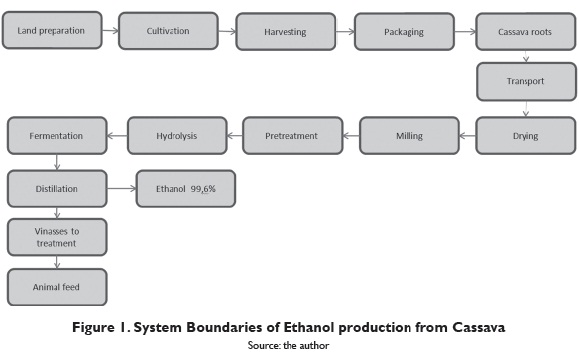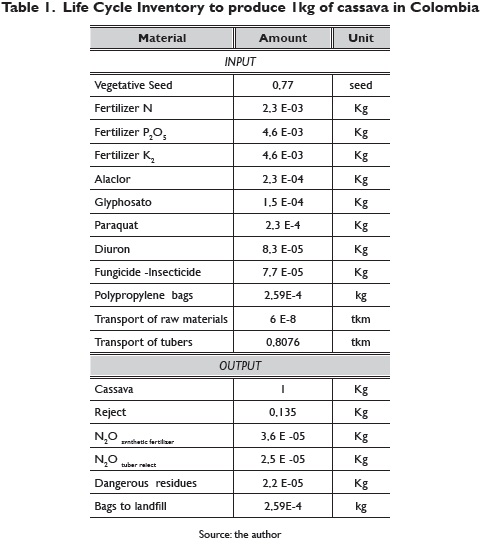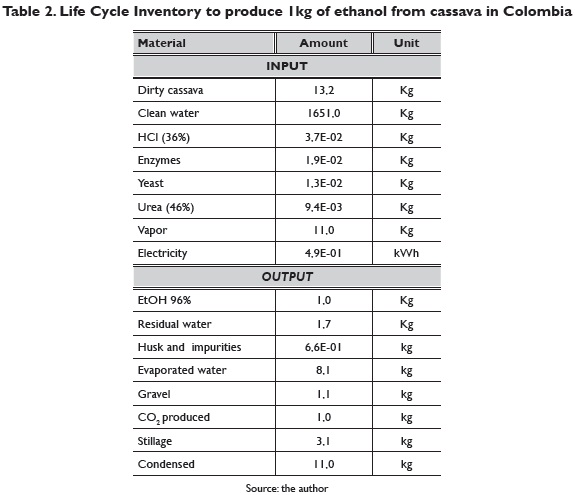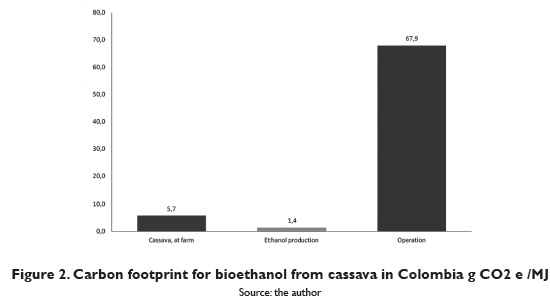Serviços Personalizados
Journal
Artigo
Indicadores
-
 Citado por SciELO
Citado por SciELO -
 Acessos
Acessos
Links relacionados
-
 Citado por Google
Citado por Google -
 Similares em
SciELO
Similares em
SciELO -
 Similares em Google
Similares em Google
Compartilhar
Producción + Limpia
versão impressa ISSN 1909-0455
Rev. P+L v.6 n.2 Caldas jul./dez. 2011
Life Cycle Assessment for bioethanol produced from cassava in Colombia
Evaluación del ciclo de vida del bioetanol producido a partir de la yuca en Colombia
Avaliação do ciclo de vida do bioetanol produzido a partir da mandioca na Colômbia
1Politécnico Jaime Isaza Cadavid Cra 48 N 7-151. Medellín, Colombia.
2GAIA S.A. Medellín Colombia
Correspondencia: Hader Castaño Peláez, e-mail: hicastanopelaez@elpoli.edu.co
Artículo recibido: 19/10/2011; Artículo aprobado: 20/11/2011
Abstract
Colombia has recently started the production of Biodiesel from palm oil and Bioethanol from sugarcane. The bioethanol in Colombia replaces 8% of the national consumption of fuel for transportation and it represents nearly 263.340 gallons per day. A life-cycle energy and environmental assessment was conducted for bioethanol production from cassava in Colombia. The scope covered all stages in the life cycle of bioethanol. In the Life Cycle Assessment the impact assessment method used is IPCC2007 GWP100a, for global warming. In all stages of the life cycle there are important impacts for the use the bioethanol in a car. At other stages, ethanol production is important for the product's environmental impact. The carbon footprint of the bioethanol from cassava is 65gCO2e/MJ. The energy conversion efficiency of fuel ethanol is 1.34.
Key words: Life Cycle Assessment (LCA), bioethanol, cassava, Colombia.
Resumen
Colombia recientemente comenzó la producción de biodiesel a base de palma y bioetanol de caña de azúcar. El bioetanol en Colombia reemplaza 8% del consumo de combustible para transporte y representa cerca de 263.340 galones al día. Se ha llevado a cabo una evaluación del ciclo de vida energético y de la parte ambiental para la producción de bioetanol en Colombia, cubriendo todas la etapas en el ciclo de vida del bioetanol. En la Medición de Ciclo de Vida el método de evaluación del impacto utilizado es IPCC2007 GWPIOOa para calentamiento global. En todas las etapas del ciclo hay impactos importantes en cuanto al uso de bioetanol en carros. En otras etapas, la producción de etanol es importante para el impacto ambiental del producto. La huella de carbón del bioetanol a base de yuca es 65gC02e/MJ. La eficiencia en la conversión de energía del etanol es 1.34.
Palabras clave: evaluación del Ciclo de Vida (ECV), bioetanol, yuca, Colombia.
Resumo
Colômbia recentemente começou a producáo de biodiesel a base de palma e bioetanol de cana de açúcar. O bioetanol na Colômbia substituí 8% do consumo de combustível para transporte e representa cerca de 263.340 galóes ao dia. Levou-se a cabo urna avaliacáo do ciclo de vida energético e da parte ambiental para a producáo de bioetanol na Colômbia, cobrindo todas a etapas no ciclo de vida do bioetanol. Na Medicáo de Ciclo de Vida o método de avaliacáo do impacto utilizado é IPCC2007 GWPIOOa para aquecimento global. Em todas as etapas do ciclo há impactos importantes quanto ao uso de bioetanol em carraças. Em outras etapas, a producáo de etanol é importante para o impacto ambiental do produto. A impressáo de carváo do bioetanol a base de mandioca é 65gC02e/MJ. A efciência na conversáo de energía do etanol é de 1.34.
Palavras importante: avaliacáo do Ciclo de Vida (ECV), bioetanol, mandioca, Colômbia.
Introduction
Colombia has a developed policy for biofuels, which includes criteria for sustainable, agro industrial development and energetic independence. Therefore, the Colombian government has included one law in 2001(Law 693)1, with the rules for the use of bioethanol, and the economic incentives for production, commercialization and consumption. In 2003, the 180687 resolution included a blend of 10% for bioethanol with petrol in combustión for cars2. In 2004, a new law for the use of biodiesel was developed. In 2008, the government created an Intersectoral Commission for Biofuels Management, made up by five ministries (Agricultura, Energy, Environment, Transport and Trading). This commission approved the "Lineamientos de Política para Promover la Producción Sostenible de Biocombustibles en Colombia" (CONPES 3510)3. ("Policy Guidelines to Promote Sustainable Biofuel Production in Colombia"). In 2009, the government established that, from 2012 on, vehicles with 2000 cm3 engines manufacturad, assembled, imported, distributed and marketed in Colombia, must be arranged so their engines can run Flex-fuel (E85) (1135 decree)4-5. Since 2010, the blend with bioethanol was 8% (Resolution 18, 2367) and 7% for biodiesel (Resolution 18, 2367). However, in December 2010, the heavy rains in Colombia brought by "La Niña" phenomenon and the decrease of the sugarcane production, forced the government to reduce the blend to 0% in biofuels (Resolution I82270)6.
Colombia was producing an average of 785.000 bbl for 2010, and has 2000 millions of barrels as proved reserves of oil. It represents only seven years of reserves7. The decrease of the national reserves of oil forced the government to stimulate policies for biofuels production. As a response to the policies for ethanol production, from 2005 the sugar mills included in their facilities the ethanol production, for 324,7 millions of liters per year. The ethanol capacity of production in Colombia in 2009 was 1'275.000 liters per day in six companies [8]. "La Niña" phenomenon brought heavy rains in Colombia, caused foods and loss of sugarcane crops and affected the ethanol production (average Jan-Nov 25 millions per month, 5 million in December)8. On the other hand, the increasing demand of bioethanol for its blending with gasoline motivates the construction of new ethanol plants. Some of them are starting operations in 2011 and 2012. The new projects have a 1,5 million /day capacity8.
Cassava is another great alternative bioethanol source for Colombia. The cassava production in Colombia, in 2009, was 1'984.427 tons in 182.313 hectares9. The average productivity was 1 lt/ha. Productivity rates of 40 t/ha have been reported. Nowadays, in Colombia, the Sumprocol Company is carrying on the Cantaclaro's project for ethanol production from cassava, with a future production of 1.000.000 liters per day. At this moment the project is in its pilot plant scale, with 25.000 liters per day.
Simultaneously the Colombian government, through its Agriculture and Rural Development Ministry, has supported researches on cassava bioethanol production at a lab scale with universities and research centers. The projects had allowed obtaining ethanol concentrations in 15% v/v., with productivities of 4g/l-h and a 97% performance by simultaneously integrating enzymatic hydrolysis and fermentation, in batch and continuous mode10. Based on these performances and on the benefits of the cassava crops, those projects will be an important energetic alternative source for the bioethanol production. They will allow the development of environmental policies and energetic requirements and, also, they can be an important rural labor source for the economy in the country.
The Life Cycle Assessment is an important tool to quantify the environmental impacts in different stages of the life cycle, soil preparation, harvesting, transportaron, production and use for biofuels. It is based on the ISO 14040 and ISO 14044 standards, and allows the identification of hot spots in biofuels production, comparisons with other energetic sources and the evaluation of some impact categories such as climate change, acidification, eutrophication, ecotoxicity and photo oxidants.
Thailand and China lead the world's production of ethanol from cassava. Such leadership is supported by the definition of public policies. Studies of Life Cycle Analysis made in these countries show results that indícate the need for standardized inventory methodologies and tools, so it is necessary to keep in mind that the results of a LCA study depends on the type of technology used and on the quantity and type of material and energy requirements.
Malakul and Papong11 developed an environmental analysis and life energy cycle to produce ethanol from cassava in a commercial plant in Thailand, and found that the production has a negative net balance. On the contrary, Dai and other12 investigated the energy and renewable energy efficiency of cassava fuel ethanol in Guangxi, which showed positive net energy and net renewable energy. Leng and other13 concluded that cassava-based ethanol is energetically efficient, as indicated by an energy output An input ratio of 1.28 and a major contribution to energy consumption comes primarily from the ethanol conversión phase as a result of the combustión of coal to produce energy. Nguyen and other14 conducted a study on the net energy balance and greenhouse gas (GHG) emissions of ethanol from cassava, based on a pilot plant's data of the Cassava and Starch Technology Research Unit (CSTRU). They found that the energy balance is positive and the net avoided GHG emission is 1.6 kg C02 eq. per liter of ethanol. Nguyen and Gheewala15 showed that cassava ethanol in Thailand in the EI0 form reduces environmental loads, if compared to gasoline. The positive energy valué and Net Renewable Energy valúes - 8.80MJ/I and 9.15 MJ/I respectively- found for the cassava fuel ethanol in Thailand proved that this energy is efficient. The analysis without co products energy credits, shows that Cassava fuel ethanol in Thailand is more efficient that the cassava fuel ethanol in China and the corn ethanol in USA16.
LCA studies that have been developed in the past years, showed different results due to different input data on crops, farm energy, different conversion in ethanol technology and co products energy credits. It is critical, for the starch bioethanol process, the improvement of the technology data in the inventory, due to the fact that the efficiency of the process has been increasing in the last years thanks to research projects that have brought improvements in the biotechnology fields. Yu and Toa17 studied an energy efficiency of cassava-based fuel ethanol in Guangxi, China, by the Monte Carlo method to avoid the uncertainty of the data collected, and showed that the energy balance is a net energy and energy input:output radio of 0.7 MJ/MJ.
For this reason, it is necessary to evaluate the environmental impacts in the overall life cycle assessment of this product, and determine the fossil fuels intensity for ethanol production, the carbon footprint of bioethanol from cassava and other impacts according to the Colombian conditions.
Methodology
LCA methodology used in this study was based on the ISO 14040's framework. The steps that the methodology applies are: goal and scope definition, inventory analysis, impact assessment and interpretation of the results.
Objective and scope definition
The objective of this study is to assess the commercial bioethanol production from cassava for Colombia, based on a life-cycle approach. The functional unit (FU) of this study is 1 L of 99.5% bioethanol production from cassava as an octane improvement fuel. The system boundary defines the scope for the product analysis, i.e. which life cycle stages, inputs and outputs should be included in the assessment.
Figure 1 shows the system boundaries with the different life cycle stages such as land preparation, planting, harvest, packaging, transportation to ethanol plant and conversion in the ethanol plant (drying chips, milling, hydrolysis and fermentation, distillation and storage).
Inventory Analysis
For this study, at the farm production the data were collected as primary data by surveys to farmers in Urabá, Colombia (PROTRACOY), and the Antioquia's Agriculture Secretary. These data include land preparation, cassava plantation and cassava harvest The data were compiled in LCI formats. Since the first commercial production of ethanol from cassava presents technical problems and could not start operations in 2010, the data were collected for a pilot plant in CIAT that belongs to the program CLAYUCA in Palmira, with a capacity for 200-250 liters per day. These data include the raw material used and the energy consumption.
Secondary data used in this study come from literature. The calculations and the ECOINVENT database for some items such as the production of fertilizers, herbicides, etc, all of them are imported materials.
The energy for the production of steam, used for distillation, is produced from the combustión of wood residue in boilers.
Life Cycle energy Analysis
The Net Energy Ratio (NER) was estimated through an Energy out/Energy in ratio. The inventory analysis allowed measuring the energy flows, based on the energy output and input for 1 liter of 99.5% bioethanol from cassava.
Carbón footprint
Carbón footprint methodology for this study was calculated by the use of the PAS2050 (BSI, 2008) and the ISO I4040 and ISO I4044 framework. The PAS2050 methodology consists of five steps for calculating the carbón footprint: Process map, boundaries and prioritization, data, calculation and uncertainty.
Life Cycle impact assessment
The inventory data (primary and secondary) of each step were introduced in SimaPro v7.22, to evaluate the environmental impacts using a CML 2000 method for eutrophication, acidifcation, photochemical oxidation, human toxicity, ozone layer depletion and abiotic depletion. The IPCC2007 GWPIOOa method was used for global warming. The following considerations were taken into account:
- Not including indirect formation of dinitrogen monoxide from nitrogen emissions.
- Not accounting for radioactive forcing due to emissions of NOx, water, sulfate, etc. in the lower stratosphere + upper troposphere.
- Not considering the range of indirect effects given by IPCC.
For this study the biogenic CO, uptake as a negative impact was not considered, because the cassava is a temporary crop.
Results and Discussion
Results of Inventory analysis
Table 1 presents the Life Cycle Inventory to produce 1 kg of cassava in Colombia, and Table 2 presents the Life Cycle Inventory to produce 1 kg of ethanol in Colombia.
Energy Analysis
The results show that the energy conversion efficiency of ethanol fuel was 1.34. It means that it is possible to obtain 1,34 energy units per every energy unit necessary to obtain cassava bioethanol under the Colombian conditions. These results are in accordance with Leng and other13 and You and Tao17, who concluded that cassava-based ethanol is efficient under energy terms, as indicated by an energy output: Input ratios of 1.28 and 1.43, respectively. Nguyen and other14, in a study on the net energy balance of ethanol from cassava based on a pilot plant data of the Cassava and Starch Technology Research Unit (CSTRU), found that the energy balance is positive.
Carbon footprint of cassava ethanol
The carbon footprint of cassava ethanol is 0.395kg CO2e per kg of ethanol. This means 75 g CO2eq/ MJ allowed a net reduction of 13.5 g CO2 e/MJ GHG emissions, if compared to conventional gasoline18. In a similar study, Nguyen et al [14] found a net avoided GHG emission of 1.6 kg CO2 eq. per liter of ethanol (2.05 Kg CO2 /kg ethanol i.e. 72 g CO2 e/ MJ), a value higher than that reported in this study. Figure 2 shows that the operation produces 90% of the GHG emission, and the cassava farming and ethanol production only contributes with 7.6 and 2.4% respectively.
Conclusions
The ethanol from cassava will be an alternative for the biofuels production in Colombia. Cassava crops for this purpose do not compete with the food security and creates jobs for unskilled labor force. The carbon footprint of the cassava ethanol is lower than fossil fuels, with a 20% lower footprint. The energy conversion efficiency of ethanol fuel was 1.34. This means it is possible to obtain 1,34 units of energy per every unit of energy necessary to obtain cassava bioethanol.
Acknowledgements
This research was financially supported by Politécnico Colombiano Jaime Isaza Cadavid. Acknowledgements are given to the Antioquia Agriculture Secretary, PROTRACOY Urabá, CIAT - CLAYUCA, and Ms Sonia Gallego, as well as to other data providers.
References
1. COLOMBIA. MINISTERIO DE COMERCIO. Resoluciones. [En línea]. [Citado el 10 de abril de 2011]. Url disponible en http://www.mincomercio.gov.co/eContent/Documentos/Normatividad/resoluciones/2003/R_180687_2003.pdf. [ Links ]
2. FEDERACIÓN DE BIOCOMBUSTIBLES. Biocombustibles. [En línea]. [Citado el 10 de abril de 2011]. Url disponible en http://www.fedebiocombustibles.com/files/182368.pdf. [ Links ]
3. DEPARTAMENTO NACIONAL DE PLANEACIÓN. Conpes 3510. [En línea]. [Citado el 10 de abril de 2011]. Url disponible en: http://www.dnp.gov.co/PortalWeb/Portals/0/archivos/documentos/Subdireccion/Conpes/3510.pdf. [ Links ]
4. COLOMBIA. PRESIDENCIA DE LA REPÚBLICA. Decretos. [En línea]. [Citado el 10 de abril de 2011]. Url disponible en: http://web.presidencia.gov.co/decretoslinea/2009/marzo/31/dec113531032009.pdf. [ Links ]
5. REVISTA AVANCE JURÍDICO. Documentos oficiales. [En línea]. [Citado el 10 de abril de 2011]. Url disponible en: http://www.avancejuridico.com/actualidad/documentosoficiales/2008/47211/r_mme_182367_2008.html. [ Links ]
6. FEDERACIÓN DE BIOCOMBUSTIBLES. Archivos de biocombustibles. [En línea]. [Citado el 03 de mayo de 2011]. Url disponible en: http://www.fedebiocombustibles.com/files/182367.pdf. [ Links ]
7. ACOLGEN. En línea]. [Citado el 03 de mayo de 2011]. Url disponible en: http://www.acolgen.org.co/article.php?sid=1443. [ Links ]
8. FEDERACIÓN DE BIOCOMBUSTIBLES. Cifras informativas del sector biocombustible. [En línea]. [Citado el 03 de mayo de 2011]. Url disponible en: http://www.fedebiocombustibles.com/files/Cifras%20Informativas%20del%20Sector%20Biocombustibles%20-%20ETANOL(20).pdf. [ Links ]
9. AGRONET. Análisis estadístico. [En línea]. [Citado el 30 de mayo de 2011]. Url disponible en: http://www.agronet.gov.co/agronetweb/AnalisisEstadisticas/tabid/73/Default.aspx. [ Links ]
10. AGRONET. Reporte de los Proyectos de Biocombustibles MADR. [En línea]. [Citado el 30 de mayo de 2011]. Url disponible en: http://www.agronet.gov.co/agronetweb/Busqueda/tabid/81/Default.aspx?cx=partner-pub-1752189363943883%3Arddvuaftff&cof=FORID%3A11&ie=ISO-88591&q=Yuca+etanol&sa=Buscar+en+Agronet&siteurl=www.agronet.gov.co%2Fagronetweb%2Finclude.html. [ Links ]
11. PAPONG, S. and MALAKUL P. En: Biosources Technology. 2010. Vol. 101, p. 12. [ Links ]
12. DAI, D; et al. En: Energy Convers. Manage. 2006. Vol. 47. p. 1686. [ Links ]
13. LENG; R.; et al. En: J. CIeaner Prod. 2008. Vol. 16, p. 374. [ Links ]
14. NGUYEN T. L; GHEEWALA, S. H. and GARIVAIT, S. En: Environ. Sci. Technol. 2007. Vol. 41. p. 4135. [ Links ]
15. INSTITUTO COLOMBIANO AGROPECUARIO-ICA http://dx.DOI.org.10.l065/Ica2007.06.343. [ Links ]
16. NGUYEN T. L; GHEEWALA, S. H. and GARIVAIT, S. En: Energy Policy. 2007. Vol. 35, No. 4. p. 585. [ Links ]
17. YU, S. TOA, J. En: Energy. 2009. Vol. 34. p. 22. [ Links ]
18. OEKO. Bioenergy Environmental Impact Analysis (BIAS) - Analytical Framework; prepared in collaboration with IFEU and Copernicus Institute for FAO; Darmstadt/Heidelberg/Utrecht, 2008. [ Links ]


















